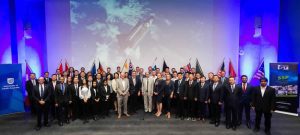The January 13 – February 14 SHSSP course includes a lecture series covering everything from space science and technology, policy and regulation to economics and business and space from a cultural perspective. Practical workshops include building and launching model rockets, a stratospheric balloon launch, cubesat building and a robotics competition.
However, the largest component of the course will be a team exercise where the group will be split. One team will look at the latest research and strategies for growing food on the moon while the other team analyses opportunities for Southern Hemisphere rocket launches with a focus on Australia.
Industry experts from groups such as the Australia’s science organisation the CSIRO will brief the moon farming group.

The SHSSP class of 2019
“NASA and ESA and the Chinese and Indian space agencies have all got plans to go to the moon and beyond to Mars so being able to make use of in situ resources and growing your own food are going to be important parts of those long-term strategies for future exploration of the solar system,” UniSA Associate Professor and SHSSP Program Co-Director Ady James said.
“Technologies develop and our ability to genetically modify and understand plants has improved but that research is always changing so they are going to look at what research has been done and what are the obstacles we still need to overcome.
“It’s still a very difficult problem – not having an atmosphere and having to create your whole environment on a rock is a big challenge.”
South Australia has a long history of launching rockets, which dates back to the development of the Woomera Rocket Range in the 1950s and the launch of Australia’s first satellite in the 1960s.
South Australian company Southern Launch, which will focus on polar orbit launches, is in a race with Equatorial Launch Australia to establish Australia’s first commercial rocket launch facility.
Associate Professor James said the SHSSP team would examine the business case and market forces for developing launch capability and sites within the Southern Hemisphere.
He said Australia was well placed to become a leader in commercial Southern Hemisphere rocket launches.
“The important thing for rocket launches really is having a down range area where you are not going to cause too much trouble when your rocket motors fall out of the sky.
“Traditionally how you do that is by launching over water or launching over deserts where there are vast areas of sparse populations.
“Being a big island, Australia has a lot more options than many nations and it’s also useful having the infrastructure, the supply chain and the high-tech industries that can support that kind of enterprise, which is harder to get in South America and South Africa.”
The SHSSP is designed for professionals involved in the international space sector, graduate researchers seeking broader knowledge of international space activities, and undergraduate students in the final two years of their studies seeking exposure to the various aspects of space.
This year’s course includes 18 participants from China, four from India as well as attendees from UAE, US, Germany, Indonesia, Israel, Italy, Mexico, Italy, Romania, Thailand and the UK.
The establishment of the Australian Space Agency in Adelaide last year and the emergence of a number of successful space startups has drawn global attention to Australia.
“There’s been more exposure to what’s happening in Australia and people are interested to see what’s going on and they are coming on this course because they see future opportunities working in and with Australia,” Associate Professor James said.
“There’s been a lot of focus in Australia on space with the space agency starting up last year and I think that’s brought a lot of people into Australia to talk about space and a lot of people from Australia have been going out to international conferences to talk about what Australia might be doing in space and looking at collaborations and partnerships.”
Four public events will be held during the SHSSP course including a national Astronaut & Human Spaceflight Panel featuring Italian astronaut Paolo Nespoli on January 18 and a stargazing presentation and evening at Mawson Lakes on January 20.

